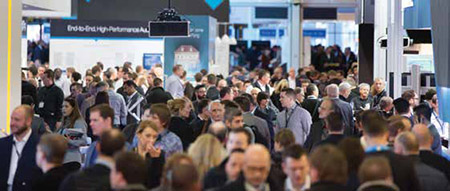REPORTING FROM ISE ON OPPORTUNITIES FOR DOING BUSINESS ABROAD
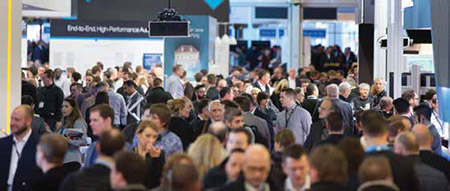
The impressive growth of the Integrated Systems Europe (ISE) show is testament to the wealth of business opportunities available across the world. The final attendance figures hit over 59,000, a 16.4 percent increase from the previous year. One time at ISE, a delightful breakfast I enjoyed with some new Italian friends took a mortifying turn. As we stood to leave, and embraced, we pecked a cheek, as is customary, except then I turned away—omitting the traditional bi-cheek convention. My polite pals couldn’t help but burst out laughing as I immediately recognized my rookie mistake and flushed.
The social and cultural differences when doing business abroad seem to be at the top of the list for Americans sharing their impressions from ISE , the largest international exhibition for AV professionals. When doing business out of country, the importance of understanding the customs and habits of your potential business associates cannot be overstated.
“What I think is very important for any company that wants to expand from the U.S. to Europe or the Middle East is really using people who have at least two cultural backgrounds, rather than just one language, one culture,” said Fardad Zabetian, founder and CEO of Media Vision.
This is the main ingredient in a recipe for success overseas, and Zabetian recommends leading expansion with this type of individual “because automatically, this person is going to be a lot more open, patient, and understanding of the whole cultural difference.”
Zabetian began his career in AV in the Middle East and went on to opportunities in Germany before moving to the United States and founding Media Vision 14 years ago. Over the years, he has done extensive business with China as well, always working very closely with systems integrators.
“We don’t even have a European headquarters,” he said. “We are so spread out. I think that’s the only way you can succeed, by focusing on each country with their own culture, with their own way of doing business.”
This is the best way to understand regional nuances, like how half of Belgium speaks French, but they don’t like doing business with French people; and how in Northern Europe and Scandinavia, people are more accepting of online meetings and correspondence via the web as a first step; whereas, in Spain, France, and Italy, they prefer to meet in person before conversing digitally.
The Big Show

The impressive growth of the Integrated Systems Europe (ISE ) show is testament to the wealth of business opportunities available across the world. The final attendance figures hit over 59,000, a 16.4 percent increase from the previous year. The show is expanding from three days to four in its next installment in February 2016. At the close of the show this past February, 94 percent of the total space available for 2016 was already sold.
Manufacturers based in the United States were once very selective about whether they would exhibit there or not, choosing to go some years and skipping others, but now, “it’s a have-to exhibition,” said Julian Phillips, executive vice president of Whitlock, and board director of the Global Presence Alliance.
Phillips, also a board director of InfoComm International, has noted a rich diversity of today’s attendees from all across Europe, the Middle East, and Asia, as well as the United States, for what was at one time a very British show in attendance, by his observance. He has also noticed more product announcements and launches happening during ISE than in previous years. Microsoft was a great example this year. While there was a comical lack of substance at the software leader’s “presence” at InfoComm last year, the Surface Hub was out in a full force for ISE 2015. While it might have made more sense to show its entry VTC solution at InfoComm, just a few months prior to the official fall launch, “but they clearly made a decision to launch in Europe,” Phillips said. “Two or three years ago, if there was another manufacturer like Microsoft, they wouldn’t have dreamed of doing it at ISE , I don’t think.”
Leaping Across the Pond
With the global markets that exist today, what was once an unapproachable prospect is now feasible for many AV integration and consulting firms in the United States.
Various models for expanding internationally exist, usually through some type of partnership. Sometimes this is by working as the project manager while hiring a local, low cost AV company to the installation, according to Zabetian. They might purchase equipment in the United States, stage all the racks and then ship them to a local subcontractor to install. Sometimes the whole project is subbed to a local integrator, which can source all the equipment in the country, enabling low cost support from manufacturers.
For Media Vision, “We have a network of dealers in the countries that we operate in Europe,” Zabetian said. “We could assist them if they are looking for referrals, if they’re looking for interviews, recommendations, and so on. For the U.S.-based companies, it’s very important that they communicate their expectations, their standards, and their client expectations whenever they want to hire a subcontractor or a partner in Europe.”
While Zabetian has seen the local subcontractor-U.S. project manager as the dominant strategy employed, the Global Presence Alliance (GP A) epitomizes the other main model of pursuing business abroad. The GP A consists of 17 members—and growing, with another three or four expected to join this year—each from a different country. With the premise that there isn’t a single AV company that can do it all around the world, the GP A used the airline industry’s Star Alliance as a model to streamline service and share best practices. “The principle being that you can actually deliver a standard set of deliverables and processes and support models, but using local knowledge and local skills to do the delivery,” Phillips said. “What each member has is, not only do they have the local knowledge and the language knowledge and the culture knowledge, they also have the distribution agreements, they have the supply and the support agreements in place. Your ability to deliver to a global organization is much better than it would be if you’re having to ship products or you’re trying to overlay another organization.”
Since it’s inception in 2008, the GP A has evolved around that conceptual foundation. “What it’s actually really started to deliver is a huge amount of shared learning and best practice,” Phillips said. “The benefit is not a transactional relationship—although we do transactions—it’s also the fact that you’ve got some of the best minds and some of the most experienced people who actually build and develop AV in these amazingly diverse, different environments. We all get together because we’re not competitive, and we just open up”
For example, one of the partners has developed a complex auto configuration system. This partner put a huge amount of effort and investments in time and money to developing the system, and they decided to make it available to the rest of the GP A members for free, a move that even surprised Phillips. The GP A has also developed a commissioning and testing standard for all global partners, based on InfoComm’s standard, and that is now being adopted by all members.
“What’s actually happening is the principle of a rising tide lifts all boats,” he said.
All in the Service
There are some interesting lessons to learn from the business practices employed by AV companies in other parts of the world. Integrators in Europe do business differently on a number of levels. A network of independent rep firms doesn’t exist, so they rely entirely on distributors in that capacity. Generally, they tend to be very efficient, less competitive with each other, and they compete with each other more on price than with service, according to Zabetian.
“If a manufacturer or systems integrator who is thinking about expanding to Europe, if they can lead with customer service, if they can lead with a quick response time, they would have an advantage,” he said.
It happens to be more commonplace for U.S. integrators to focus on service contracts more than products in some ways today, but this model hasn’t taken off as much in Europe. There seems to be an appetite for more services though. Three of the biggest deals for video-managed services that AVI-SPL has secured have been in Europe, according to Daniel Rogers, vice president, global channels. They are monitoring, managing, and hosting hundreds of end points—monitoring the room, managing the codec, launching calls, and monitoring content.
The overarching lesson from the GP A in regards to international business is that there is a global market for opportunities and skills. So while a GP A member owns an AV project contract in his or her given country, they can rely on services from their GP A partners to help them achieve an objective.
Lindsey M. Adler is editor of SCN.
Snapshots from the ISE Floor
From a show mission perspective, I tackled the floor with the goal of asking everyone I could about business lessons and practices from the international market that U.S. integrators can learn from. What follows are some general notes from the show and any insight offered on the aforementioned topic.
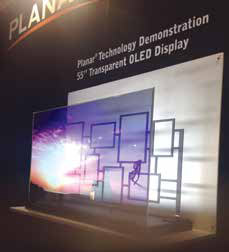
Planar made waves at ISE with a transparent OLED for more designer-oriented integrators. For Stewart Filmscreen, Peter S. Brown, VP sales and marketing, described how in Europe, installers often have to deal with old stone walls more than they do in the U.S. In-wall and in-ceiling solutions are not options in this scenario.
Conversations at Biamp’s booth were the key takeaway, with a heavy emphasis on education in both training initiatives and simply in the type of discussions initiated. The concept of Time Sensitive Networking (TSN) was one such topic Biamp was really championing. The story is part of yet “bigger than AVB,” according to Justin O’Connor, product manager, audio and conferencing.
With European business versus American, there are mostly regional economics at play. Projects can be publicly funded sooner in Europe, but the funding is shallower, in general. There’s the “Greek effect” on the Euro currently to consider. The “cookie jar is a little low” all around, right now, O’Connor said. There’s less aggression in the market in terms of competitiveness as well. In the U.S., there’s a good mix of public and private funded projects, and they’re both steadily climbing. The market is overall healthy and stable.
In Europe, project size is often huge, encompassing whole complexes with hotels or spas, according to Amanda Roe, global public relations manager. The trend is to move from huge project to huge project. In the United States, big jobs are often mixed with smaller ones.
Overall, Biamp has shipped over 15,000 AVB devices since May 2012, with the launch of the Forté line. Half of those are just in the past few months.
David Dacosta, manager in EMEA, is in charge of sales and operations and business development and technical support in Nanolumens’ recently opened UK-based office. It’s “a complete vertical organization,” he said.
What they’ve done is import the Nanolumens culture to the UK, which he described as really successful. It’s a growing family-style culture, and this extends to the customer-first, complete, bespoke systems approach. The UK office will be opening a “visualization theater” to show products in the region.
There’s a higher percent of control room installations for Planar Systems in the EMEA market, according to Steve Seminario, senior marketing manager. Planar has about 400 to 500 volume selling integrators in the U.S., but in Europe, there’s a smaller number of more longstanding integration partners. For example, there’s pretty much one big integrator in Spain that Planar works with predominantly. There’s a lot of history and loyalty in these relationships. Seminario described it as a different dynamic that fits different markets; neither as better nor worse.
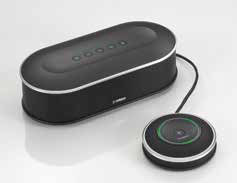
The Yamaha YVC-1000 unified communications microphone and speaker system was just introduced in EMEA and has already taken off in the Middle East. Planar made waves at ISE with a transparent OLED for more designer-oriented integrators. There were no direct plans for sales yet; Planar was demoing the display to get feedback from its partners. Potential use cases include convenience store display cases, retail digital signage, and museum wayfinding. The display can be touch-enabled as well.
In just the past few years, AVI-SPL has “grown exponentially” in Europe. In 2013, starting from scratch globally, the company was present in 19 countries; the last quarter in 2014 it was 39 countries. Employee growth internationally has gone from 15 to 90 in these two years.
“Leverage the international playbook,” was one means for this expansion, described by James Shanks, managing director, EMEA. AVI-SPL has a handful of tried and tested partners and an international project management team. They’ve been setting room standards on the enterprise level, with the expectations for the huddle room to function like large conference rooms.
The EMEA team has sold whole, bundled offerings more than its U.S. counterparts. There’s a practice of channel centric partners, getting more business through third parties like AT&T, Interpol, and Level3.
Annabelle Wellon, UK business development manager for Revolabs has observed the AV/IT bridge shrinking. The Middle East in particular is leading in the AV/IT convergence where the government is driving adoption heavily. “The time of making do is coming to an end,” she said, in reference to technology status quo in the region. From a product trend perspective, the Yamaha YVC-1000 unified communications microphone and speaker system was just introduced in EMEA and has already taken off in the Middle East, with strong sales there right off the bat.
The YVC-1000 is the first product collaboration between Revolabs and Yamaha, since the latter’s acquisition. The audio peripheral is suited for medium to large conference rooms, allowing users to connect to calls via Bluetooth or USB for BYOD flexibility.
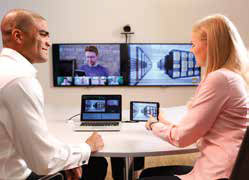
Pexip’s Infinity Platform over YouTube was a major step forward for the platform. Overall, Yamaha’s acquisition of Revolabs in March 2014 has helped fill in some gaps for both.
The wide adoption of Lync is a driving force for Pexip in both the U.S. and Europe, according to Hani Mustafa. Many of the differences in business between the two regions occur at the partner level. He considers the United States to be more traditionally AV-oriented, and he’s noticed convergence take off a bit quicker in Europe.
Pexip’s Infinity Platform over YouTube was a major step forward for the platform. This is enabled by the ability to output a dedicated multimedia stream to enterprise content delivery network (CDN) streaming and recording services, including public streaming services, such as YouTube. This means that any Pexip-powered conference can be streamed as if it were a live event, to any number of viewers, with recording and storage options, even VOD. All this is of course in high definition.
Other advances in the version 8 release of Pexip’s Infinity scalable meeting platform include interoperability with Skype, native HD access for Internet Explorer and Safari web browsers, as well as dual-stream RDP content sharing to Microsoft Lync—an important feature when working with legacy video systems.
At just the second ISE for SVSi, the Alabama company saw growth in its distributor base jump from two to 12. According to Bob Sharp, director of international sales, the European market is ahead of the U.S. when it comes to accepting the AV/IT convergence.
SVSi is positioning itself in a leadership role in convergence, looking to get AV guys to not be afraid of IT. The launch of a global AV/IT training and certification program for networked AV is part of the strategy. The program is designed to be fully objective and product agnostic to help bridge the gap between traditional AV and IT certifications. The appointment of industry veteran Max Kopsho to lead this project was a strategic move.
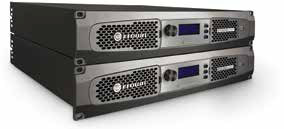
New at ISE, AVB certification was added to the DriveCore Install (DCi) with the addition of eight and four channel amps (DCi 8|600ND and 4|1250ND). In Asia, the cinema market is seeing “tremendous” expansion, 20 percent, said Crown’s Daniel Saenz, business segment manager for install and cinema sound. Other markets showing strength globally for Harman include conference rooms, especially with Crown, and hospitality, the latter growing most.
Crown’s DriveCore amps have seen wide adoption in the industry recently. They’ve become a go-to product for many integrators, Saenz said, adding that they have grown the install segment significantly. The growth “was startling to us.”
New at ISE, AVB certification was added to the DriveCore Install (DCi) with the addition of eight and four channel amps (DCi 8|600ND and 4|1250ND). With the introduction of Soundweb London BLU-DAN Dante to BLU link Bridge, connecting BLU devices with a Dante network, Harman now plays nice with AVB, Dante, and Cobranet.
ISE was an opportunity for Community Professional Loudspeakers to unveil a new brand identity, in addition to officially launching the I Series, which CEO Steve Johnson described as “the product embodiment of the rebranding,” speaking to the new face of the company. Contemporary industrial design was the product design focus, reflecting a modernization Community has made in response to customer needs, the global market, and technical advances. The rebranding combines these ideas while nodding to the company’s rich history in the industry.
The I Series is a top line, point-source install loudspeaker with contemporary industrial design and clever rigging hardware.
—LA
